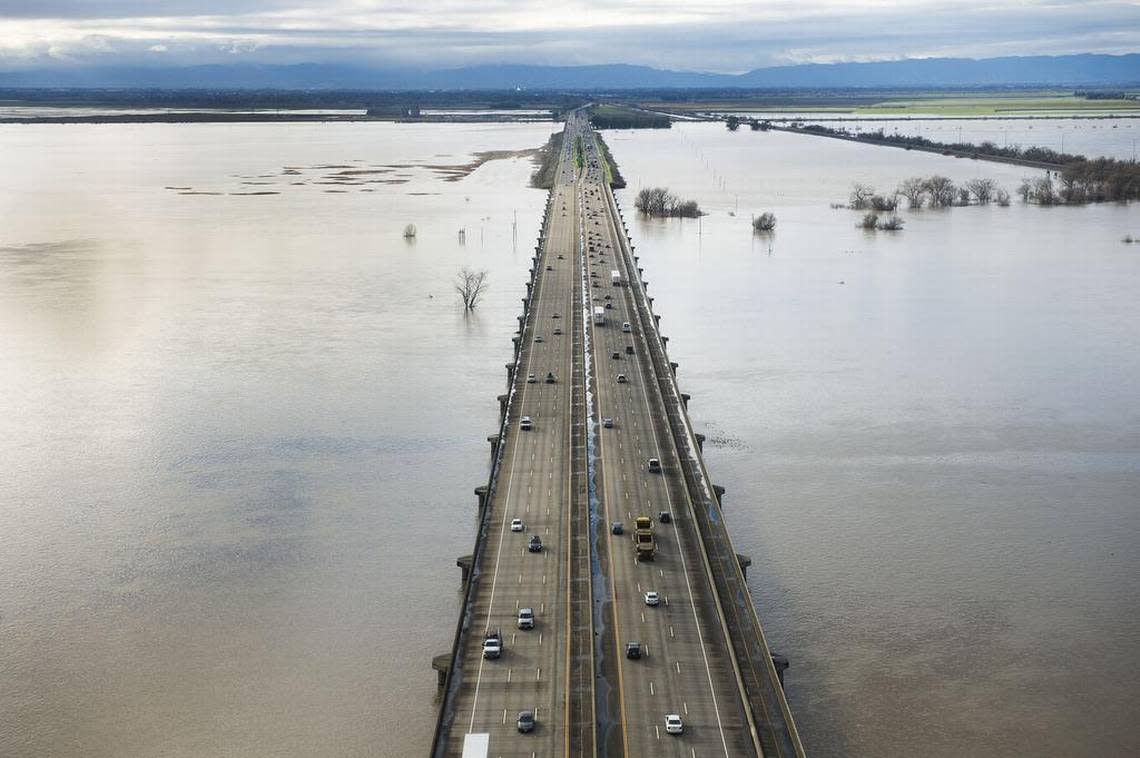Will Sacramento freeways get multiple express lanes like planned? Judges will decide | Opinion

- Oops!Something went wrong.Please try again later.
The battle against climate change was supposed to completely change our freeway experience in the Sacramento region, with lofty plans for two express lanes each way on many heavily used routes in the future. But the road builders at the California Department of Transportation simply aren’t ready.
The question is whether Caltrans’ recalcitrance even to analyze multiple express lanes between downtown Sacramento and Davis as part of an approved expansion project is downright illegal. And now that the Newsom administration has been sued twice on the matter, the coming answer by the courts will shape future freeway projects here and throughout the state.
“We felt like this was a poster child project for highlighting this problem,” said Howard Penn, executive director of the Planning and Conservation League, a plaintiff in one of the lawsuits. “Why do we have these climate goals? If we’re not taking this seriously, let’s acknowledge that we don’t care.”
In California, paying a toll to drive down the road, or being forced to commute with a fellow worker or a neighbor, is about as popular as a root canal. But in this quest to lower our emissions of global-warming gasses, this is where this climate change adaptation is now leading us.
Opinion
Many motorists undoubtedly would prefer Caltrans’ plan for only a single express lane between Sacramento and Davis, and only at rush hour, in its so-called Yolo Corridor Improvements Project. But the Sacramento area’s most important contribution to battling climate change is driving less. So what are our real priorities? This humble stretch of interstate is about to help the state decide what truly is important.
Caltrans spokesman Dennis Keaton said the department hopes to start construction next spring. While not commenting on the litigation, Keaton said, “This Caltrans project has been thoroughly vetted by state and federal officials, including the Environmental Protection Agency and the Federal Highway Administration, and approved by the California Transportation Commission. The new tolled express lanes are expected to reduce delays for motorists and improve goods and freight movement as some passenger vehicles and buses switch from the general-purpose lanes to the express lanes.”
Legally speaking, however, Caltrans appears to be on some thin ice.
State law requires any environmental analysis to examine a range of alternatives. In this case, Caltrans ignored the official strategy of the Sacramento region’s transportation planners.
The Sacramento Area Council of Governments has its own legal requirement to adopt and update a plan to lower regional emissions through smarter housing and transportation strategies. And as part of its existing strategy, SACOG assumed that an expanded Interstate 80/50 between Sacramento and Davis would have two express lanes for carpoolers and toll-paying drivers at rush hour. This would require turning one of the three existing lanes into an express lane during peak driving times.
Asked last year why Caltrans ignored the SACOG alternative, spokesman Dennis Keaton said, “A multiple express lane alternative was never requested by SACOG to be analyzed.” Yet examining alternatives is the law. Complying with regional plans is also in Caltrans’ guidelines.
Environmental groups have made these glaring weaknesses the basis of lawsuits filed in Alameda County Superior Court. The groups include the Sierra Club, the Environmental Council of Sacramento, PCL, the Natural Resources Defense Council and the Center for Biological Diversity.
“Our goal is for Caltrans and..the governor to look at how they’re doing business,” said Don Mooney, a Davis-based attorney leading one of the cases. The widening project is “really inconsistent with what California professes it is going to be doing.”
The most formidable adversary for Caltrans may not be these environmental groups, but the wing of the Newsom Administration that is on the front lines of the battle against climate change.
The California Air Resources Board blasted this project publicly, calling the Caltrans environmental analysis bogus because it underestimated the emissions this project would cause while overestimating its benefits. When a sister state agency is not on your side, that can spell trouble in court.
The schizophrenia of the Newsom administration is not lost on Penn of PCL. “Caltrans has had an organizational culture for decades…that hasn’t changed much,” he said. “I feel that the governor is doing everything he can to change that.”
Environmental lawsuits don’t necessarily halt projects. An Alameda jurist would have to issue an injunction preventing Caltrans from proceeding with the project while the case goes to trial.
“It’s certainly one of the things we’re going to be looking at,” Mooney said.
By inviting this litigation due to ignoring its administration and the regional transportation strategy, Caltrans is “willing to risk hundreds of millions of dollars of funding,” Mooney said. The whole project is estimated to cost $465 million.
Regardless of the outcome, this is likely the last time Caltrans can get away with refusing to look at Sacramento-area freeway projects that result in two express lanes each way. SACOG Executive Director James Corless has made that formal request to Caltrans, in an email obtained by the California Public Records Act. The next likely widening project would be Interstate 5 between downtown Sacramento and the international airport.
The less we drive, the less we warm the planet. The era of shared sacrifice is supposed to have arrived. Newsom, who is now busy moving his family away from the capital region to Marin, will be yet another long-distance commuter on Interstate 80. The state is paying a heavy toll for Newsom’s inability to force his transportation department to take climate change seriously.

